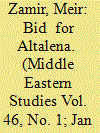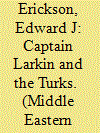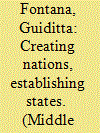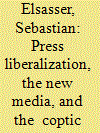|
|
|
Sort Order |
|
|
|
Items / Page
|
|
|
|
|
|
|
| Srl | Item |
| 1 |
ID:
093759


|
|
|
|
|
| Publication |
2010.
|
| Summary/Abstract |
Based on documents recently discovered in French archives, the article sheds new light on the role of France, especially of its Foreign Minister Georges Bidault, in providing arms and ammunition to the Etzel - the pre-state underground Zionist movement in Israel. The ship Altalena, which was sunk by the newly-formed Israel Defence Forces in the midst of the 1948 War of Independence, remains a centre of historiographical and political controversy in Israel. France's role in this affair is examined in the wider context of its clandestine intelligence, military and diplomatic assistance to Israel, as well as its rivalry with Britain in the Middle East. The article argues that Bidault's decision was intended to undermine Britain's secret support during the war in Palestine for King Abdallah of Jordan's occupation of Jerusalem. Documents, including a report of a committee of inquiry of the French Ministry of Defence into the Altalena affair, are annexed.
|
|
|
|
|
|
|
|
|
|
|
|
|
|
|
|
| 2 |
ID:
093763


|
|
|
|
|
| Publication |
2010.
|
| Summary/Abstract |
The 'Holiday of Holidays' is a unique event of coexistence in the Israeli landscape as well as in the entire Middle East. The festival unites the three religions: the Christian Christmas, the Jewish Hanukkah and the Muslim Ramadan. It has been taking place for the past 15 years in November-December in the Wadi Nisnas neighbourhood of Haifa, Israel. This is a colourful celebration of art, music, fragrances, tastes and magnificent holiday lighting that creates syncretism between old and new, languages and religious symbols. The organizers choose universal elements: food, commerce and art, which are disengaged from conflictual contexts. Beyond the commercial-tourist aspect, this festival creates 'another place' with encounters between hostile groups.
|
|
|
|
|
|
|
|
|
|
|
|
|
|
|
|
| 3 |
ID:
093765


|
|
|
|
|
| Publication |
2010.
|
| Summary/Abstract |
The voyages of the HMS Doris along the Mediterranean coast near Alexandretta (modern Iskenderun, Turkey) in the winter of 1914-15 had a dramatic effect on the Ottoman Empire that far exceeded the scope of the operations. This article uses British, German, and Turkish archival sources to focus on the ship's operations in the vicinity of Dortyol and on the strategic impact these had on Ottoman perceptions of threats to the empire. The Doris figures prominently in two critical strategic outcomes - the relocation of the Armenians in 1915 and in the activation of three Ottoman army divisions for coastal defence and internal security.
|
|
|
|
|
|
|
|
|
|
|
|
|
|
|
|
| 4 |
ID:
093758


|
|
|
|
|
| Publication |
2010.
|
| Summary/Abstract |
This article explores the creation of modern Iraq in the period between the Armistice of Mudros in October 1918, marking the end of the First World War in the Middle East, and the conclusion of a formal peace treaty with Turkey in 1923. It looks at how far the British occupiers considered the ethno-religious character of the population while defining frontiers and political system in the territory, focusing on the three major ethno-religious groups in Iraq: Shia Arabs, Sunni Arabs and Kurds. It shows that British policy, influenced by the state of Anglo-Turkish relations, the relationship between officials in London and officials in Baghdad, and British economic necessities and public sentiments towards imperialism, evolved through three main phases: progressively, ethnic and religious factors receded in significance.
|
|
|
|
|
|
|
|
|
|
|
|
|
|
|
|
| 5 |
ID:
093760


|
|
|
|
|
| Publication |
2010.
|
| Summary/Abstract |
The subject of this article is creation of a set of exotic images used by the early tourist industry to market Morocco. The author argues that Edith Wharton's book, In Morocco, was instrumental in this process. The images conveyed by Wharton are described, explained, and linked to similar images appearing in tourist publications.
|
|
|
|
|
|
|
|
|
|
|
|
|
|
|
|
| 6 |
ID:
093764


|
|
|
|
|
| Publication |
2010.
|
| Summary/Abstract |
The introduction of new media (internet, satellite TV) in the 1990s and the liberalization of the Egyptian press in the 2000s have brought the Coptic minority and its demands for equality and recognition to the forefront of public debate in Egypt. The consequences are diverse: more and sometimes better information and more room for the discussion of uncomfortable truths on the one hand, irresponsible sensationalism, the propagation of new and old prejudice, and a further strengthening of exclusive religious identities on the other hand. Government policies, though, rightly criticized as contributing to the current crisis in Muslim-Christian relations, have so far remained unaffected.
|
|
|
|
|
|
|
|
|
|
|
|
|
|
|
|
| 7 |
ID:
093761


|
|
|
|
|
| Publication |
2010.
|
| Summary/Abstract |
The primary aim of this article is to examine the policies of the elite in Iran in relation to political parties and organizations that have emerged between 1979 and 2009. It also attempts to argue that the politics of factionalism has proven to be incapable of creating a viable political system. On the other hand, it has been difficult to anticipate the emergence of a system based on party politics in Iran more than three decades after the revolution. The findings of this article demonstrate how determined the elite were in shaping politics in Iran, and will also show that the move away from factionalism to a system based on party politics between 1997 and 2009 faced stiff opposition from the conservative elite. The situation polarized politics in Iran and further increased intra-elite factionalism. This article relies mostly on Iranian primary sources, accessing opinions that have not yet been published or discussed. The focus is on examining the relationship between high-ranking members of the elite and organizations representing different interests within the system that came to existence either before or immediately after the revolution in 1979.
|
|
|
|
|
|
|
|
|
|
|
|
|
|
|
|
| 8 |
ID:
093762


|
|
|
|
|
| Publication |
2010.
|
| Summary/Abstract |
In championing women's rights, Semseddin Sami (1850-1904) sought to remould Ottoman social conscience along an egalitarian ethic based on gender equality in intelligence. In his novel Taassuk-i Talat ve Fitnat, his treatise Women, and his six-volume encyclopaedia Kamus al-A'lam, he offered the ideal of monogamous marriage based on love and forgiveness, underscored the imperative of female education and job opportunities, and demonstrated the wide range of women's achievements throughout Islamic and Western history. The remaking of men needed to complement the remaking of women. Detailed studies of individual writers and magazines are necessary to gain an appreciation of the struggle to redefine the dignity of women in the late Ottoman Empire.
|
|
|
|
|
|
|
|
|
|
|
|
|
|
|
|
|
|
|
|
|